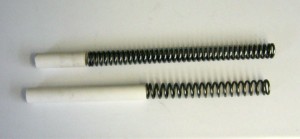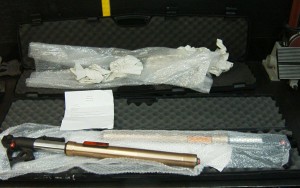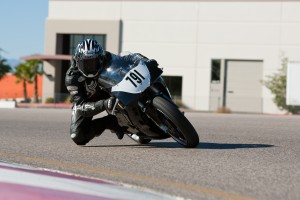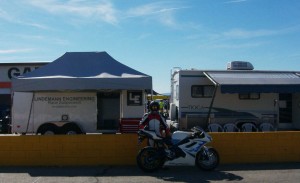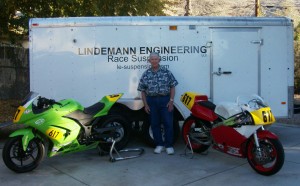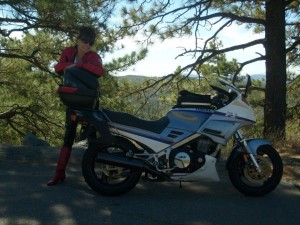Less spring = Faster bike
The spring on top in this photo came out of the F2 front end on my ‘88 CBR 600F1. Back then springs were long. Now days, springs are a lot shorter. I saved 300 grams in each fork by replacing the long springs with shorter springs of the same rate and longer spacers.
Yes, the rate increases the more you compress a spring but not by much. I think the advantage of less weight is greater than the problem caused by a slight rate increase near the end of the forks travel.
Magic Gun Cases
A Gun Case is a great way to ship forks, you can even take them on a plane to a race. Jim had a bunch of gun cases here and there in the shop. I put them to work shipping forks back to customers when I didn’t have a good box. Turns out most of the cases have some kind of magic because they keep coming back with new jobs. The case in the back is on it 3rd round trip and the case in front contains a 2nd set of forks from the same person. Or maybe it just the good work…
MG’s Vegas Report
“Here’s me on the TZ-based bike (Ed hates calling it a TZ) at Vegas. It was my first race on the bike, and I was uncomfortable and tentative. Although the lap times dropped as Ed tweaked things, when I got worn and felt I’d hit my limit for the weekend, I packed up. When I learned to ski, I was told by a Ski Patrol member that people got hurt when they’d say, ‘Just one more run.’ I’ve never forgotten that. I ride within my limits and come back to race another day. We had identified some areas (on bike and rider!) that need work, and we have a plan to do that. Success in racing, track days or street riding starts with a plan based on evaluation and feedback, and sticking to that plan pays dividends.”
Nov 25th
All American Racing Hero
Tyler is smart
Tyler had a blast and learned a lot at Rich Oliver’s Mystery School. After the school was done he got a discount card good for $50 off on suspension work at Lindemann Engineering. Being the smart guy that he is, Tyler then called Ed at LE and ordered a Penske shock and sent his R-6 forks for rebuild, re-valve and new springs.
Tyler is signed up for a MotoYard.com track day Dec 3rd at CVR where he will put the new skills he learned from Rich to work and where Ed will dial in his suspension settings, no extra charge.
You too can be as smart as Tyler.
Happy Riders
Craig just got a new Penske for his FJ1200 and he took his wife for a ride. Looks like she is happy too. Here’s what Craig said:
“First, thanks for the follow up. Yeah, the bike handles better than ever. I’m sure its even better than when it rolled out of the factory. The sag was all but perfect out of the box. “
It all starts with the correct spring rate. See the Penske Art post bellow. Now Craig is playing with the clickers and learning. The follow up he is talking about is just some e mail to make sure all is well and answering any set up questions.
I don’t want to make a few hundred dollars off you from one job, I want all your suspension money for as long as you ride. Therefore I try to explain and answer.
Penske Art
Why does Penske need two weeks to build your shock?
They don’t, it really only takes a few hours to build a shock but we say two weeks to give time to get all the parts together and to get in line behind the other pending orders.
So the real question is, why does Penske build your shock to order instead of building them on an assembly line?
Building your shock to order allows Penske to start with the correct spring rate for your weight. Spring rate determines how strong your rebound valving needs to be. A stronger springs needs more rebound valving to control it. On the compression side, the valving works with the spring rather than controlling it so a standard valve stack can be developed for different levels of riding.
I call Penske’s standard compression valve stack a “Street” stack as most Penske’s are used on street bikes. You can also have a LE “Track Day” or “Race” stack.
Your new Penske will be shipped direct to you and I will be your contact for questions, help or warranty.
The spring pre-load will be set at 10mm. The damping adjusters will be in the middle of their range, for example, 15 of 30 rebound clicks. This will give you a wide range of adjustment. Let me take this opportunity to encourage you to test your new Penske’s full range of adjustments so you understand what they do.
Up to 58
Hawaii Raceway Park, 7 configurations, 1983 – 1997
Willow Springs, 1986
Seattle International Raceway, 1990
Portland International Raceway, 1990
Heartland Park Raceway, 1990
Memphis Raceway, 1998
Road Atlanta, 1990
Nelson Ledges, 1991
Suzuka,
Ford Island, Pearl Harbor, 1997
Pomona AMA course, 1996?
Streets of Willow, 1998
Phoenix Speedway, 1998
Daytona Int. Speedway, 1998
Laguna Seca, 1998
Sears Point Raceway, 1998
Infineon Raceway, 2000
Road America, 1998
Loudan, 1998
Indy, 1998
Button Willow, 1998
Button Willow Backwards, 2007
Las Vegas Speedway, 1998
Robling Road, 1999
Mosport International Raceway, 1998
Mid Ohio, 1999
Shannonville, 1999
Brainerd Int. Raceway, 1999
Shube, 1999
Pikes Peak, 1999
Virginia Int. Raceway, 2000 ?
California Speedway, AMA Course, 2000 ?
California Speedway, Interior Test Circuit, 2004?
Mid America, 2003 ?
Barber Motorsports Park, 2001 ?
Miller Motorsports Park, AMA Course, 2007 ?
Miller, Full Course, 2008 ?
Talladega Grand Prix Raceway, 2005
Horse Thief Mile, 2000
Spring Mtn. Motorsports Ranch, 2004
Jennings, 2007
ICAR, 2010
New Jersey, Lightening Course, 2010
Mosport International Raceway’s Rider Development Track, 2011
Race City, 2011
Race City Mini Track, 2011
Mosport Kart Track, 2011
Chuckwalla Valley Raceway, 2011
Willow Springs Kart Track, 2011
Grange Kart Track, 2004
Streets of Willow Counter Clockwise. 2011
Las Vegas Classic Course, 11/3/12
58 Tracks so far.
Ed Sorbo International Invitational
Davis Wins Inaugural Ed Sorbo International Invitational Race With WERA West
Jim Davis took the win in the first-ever Ed Sorbo International Invitational race, part of the WERA West event at Las Vegas Motor Speedway.
Sorbo himself was second, and Keith Stie completed the podium in the eight-rider field.
WERA created the Ed Sorbo International Invitational as a new wave in an existing race on the schedule, as long as Sorbo could convince five riders to sign up for the class. There was no shortage of riders willing to take part at Vegas.
Sorbo says the event succeeded precisely in what it was designed to do – get more riders onto the grid, and provide a low-pressure opportunity for racers to get onto the racetrack. Sorbo is hopeful that the idea of a catch-all class that centers around riders, rather than machines, can be adopted by other organizations looking for ways to add value to their racing series for their current customers and for ways to attract new racers into the sport. Sorbo pointed out that, with no additional cost to WERA, the race organization generated several new paid entries each day.
“I hope everyone will take this idea and modify it to make it work for their region, their club, their home race track,” Sorbo says. “It’s an opportunity for friends who would never be able to race each other because they are on different machines to get on the track and race each other. It’s an additional class for racers who just want more time on the track. And it’s perfect for the racer who just wants to spend more time with their knee on the ground.”
In Sunday’s race, Chris Schatz took the win, with Jim Davis second and Keith Stie third.

